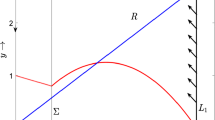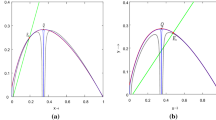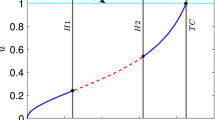Abstract
In this paper, we study a slow–fast Leslie-type predator–prey model with piecewise-linear functional response. Our approach is based on the geometric singular perturbation theory and the canard theory. When the fold point of the critical curve is lower than the transcritical bifurcation point, theoretical and numerical analyses show that a supercritical super-explosion occurs near the non-smooth corner followed by an inverse canard explosion close to the smooth fold. The critical values of parameters corresponding to these dynamical behaviors are obtained. Moreover, a stable relaxation oscillation is generated by the supercritical super-explosion, which will vanish as the occurrence of the inverse canard explosion.








Similar content being viewed by others
References
Benoit, E., Callot, J.L., Diener, F., Diener, M.: Chasse au canard. Collect. Math. 32, 37–119 (1981)
Eckhaus, W.: Relaxation Oscillations Including a Standard Chase on French Ducks. Lecture Notes in Mathematics, vol. 985. Springer-Verlag, Berlin (1983)
Krupa, M., Szmolyan, P.: Relaxation oscillation and canard explosion. J. Differ. Equ. 174, 312–368 (2001)
Krupa, M., Szmolyan, P.: Extending geometric singular perturbation theory to nonhyperbolic points-fold and canard points in two dimensions. SIAM J. Math. Anal. 33, 286–314 (2001)
Dumortier, F., Roussarie, R.H.: Canard Cycles and Center Manifolds. Memoirs of the American Mathematical Society, Providence (1996)
De Maesschalck, P., Dumortier, F., Roussarie, R.: Canard Cycles: From Birth to Transition. Springer, Berlin (2021)
Brøns, M., Krupa, M., Wechselberger, M.: Mixed mode oscillations due to the generalized canard phenomenon. Fields Inst. Commun. 49, 39–63 (2006)
Desroches, M., Guckenheimer, J., Krauskopf, B., Kuehn, C., Osinga, H.M., Wechselberger, M.: Mixed-mode oscillations with multiple time scales. SIAM Rev. 54, 211–288 (2012)
Szmolyan, P., Wechselberger, M.: Canards in \({\mathbb{R} }^{3}\). J. Differ. Equ. 177, 419–453 (2001)
Wechselberger, M.: Existence and bifurcation of canards in \({\mathbb{R} }^{3}\) in the case of a folded node. SIAM J. Appl. Dyn. Syst. 4, 101–139 (2005)
Zhao, L., Shen, J.: Relaxation oscillations in a slow-fast predator-prey model with weak Allee effect and Holling-IV functional response. Commun. Nonlinear Sci. Numer. Simul. 112, 106517 (2022)
Wang, C., Zhang, X.: Relaxation oscillations in a slow-fast modified Leslie-Gower model. Appl. Math. Lett. 87, 147–153 (2019)
Carmona, V., Fernández-García, S., Teruel, A.: Birth, transition and maturation of canard cycles in a piecewise linear system with a flat slow manifold. Physica D 443, 133566 (2023)
Rotstein, H.G., Coombes, S., Gheorghe, A.M.: Canard-like explosion of limit cycles in two-dimensional piecewise-linear models of FitzHugh-Nagumo Type. SIAM J. Appl. Dyn. Syst. 11, 135–180 (2012)
Desroches, M., Fernández-García, S., Krupa, M., Prohens, R., Teruel, A.E.: Piecewise-linear (PWL) canard dynamics: simplifying singular perturbation theory in the canard regime using piecewise-linear systems. Nonlinear Systems, Vol. 1 : Mathematical Theory and Computational Methods, Springer, Cham (2018)
Desroches, M., Freire, E., Hogan, S.J., Ponce, E., Thota, P.: Canards in piecewise-linear systems: explosions and super-explosions. Proc. R. Soc. A Math. Phys. Eng. Sci. 469, 20120603 (2013)
Roberts, A., Gendinning, P.: Canard-like phenomena in piecewise-smooth Van der Pol systems. Chaos 24, 023138 (2014)
Roberts, A., Saha, R.: Relaxation oscillations in an idealized ocean circulation model. Clim. Dyn. 48, 2123–2134 (2017)
Roberts, A.: Canard explosion and relaxation oscillation in planar, piecewise-smooth, continuous systems. SIAM J. Appl. Dyn. Syst. 15, 609–624 (2016)
Ai, S., Sadhu, S.: The entry-exit theorem and relaxation oscillations in slow-fast planar systems. J. Differ. Equ. 268, 7220–7249 (2020)
Li, S., Wang, X., Li, X., Wu, K.: Relaxation oscillations for Leslie-type predator-prey model with Holling Type I response functional function. Appl. Math. Lett. 120, 107328 (2021)
Li, S., Wang, C., Wu, K.: Relaxation oscillations of a slow-fast predator-prey model with a piecewise smooth functional response. Appl. Math. Lett. 113, 106852 (2021)
Seo, G., DeAngelis, D.L.: A predator-prey model with a Holling type I functional response including a predator mutual interference. J. Nonlinear Sci. 21, 811–833 (2011)
Seo, G., Kot, M.: A comparison of two predator-prey models with Holling’s type I functional response. Math. Biosci. 212, 161–179 (2008)
Zhang, Y., Xu, Z., Liu, B., Chen, L.: Dynamic analysis of a Holling I predator-prey system with mutual interference concerning pest control. J. Biol. Syst. 13, 45–58 (2005)
Saha, T., Pal, P.J., Banerjee, M.: Slow-fast analysis of a modified Leslie-Gower model with Holling type I functional response. Nonlinear Dyn. 108, 4531–4555 (2022)
Arnold, V.: Dynamical Systems V: Bifurcaton Theory and Catastrophe Theory. Springer, Berlin (1994)
Zegeling, A., Kooij, R.E.: Singular perturbations of the Holling I predator-prey system with a focus. J. Differ. Equ. 269, 5434–5462 (2020)
Dumortier, F., Roussarie, R.: Canard cycles with two breaking parameters. Discrete Contin. Dyn. Syst. 17, 787 (2007)
Acknowledgements
The authors are supported by the NSF of China (NO. 12271096), the NSF of Fujian Province (NOS. 2022J02028, 2023J01994, 2023J01299) and the Young Top Talent of Fu-jian Young Eagle Program. We are very grateful to the editor and the anonymous reviewers for careful reading and helpful suggestions which led to an improvement of our original manuscript.
Author information
Authors and Affiliations
Contributions
Huiping carried out computations and wrote the initial manuscript text and Yuhua prepared the numerical simulations under the supervision of Jianhe. All authors reviewed the manuscript.
Corresponding author
Ethics declarations
Competing interests
The authors declare no competing interests.
Additional information
Publisher's Note
Springer Nature remains neutral with regard to jurisdictional claims in published maps and institutional affiliations.
Appendix
Appendix
Consider the slow–fast piecewise-smooth system in a general form, namely,
with
where \(0<\epsilon \ll 1\) is the perturbation parameter, \(\lambda \) stands for the multi-dimensional bifurcation parameters, and \(f_{1}, f_{2}\in C^{k}, k\ge 3\), in which, \(f_{1}\) is linear in x while \(f_{2}\) is a cubic-like function of x.
Let \(\Sigma =\{(x,y)|\ x=\alpha \}\) be the switching boundary, then \(\Sigma _{-}=\{(x,y)|\ x<\alpha \}\) and \(\Sigma _{+}=\{(x,y)|\ x>\alpha \}\) are respectively the left and right region in the plane. Thus, we can define the left system and the right system respectively. On the switching boundary \(\Sigma \), it is assumed that the vector field satisfies
and
where \((\alpha , y_0)\in \Sigma \) is the corner when \(\lambda =\lambda _0\), and the prime means the derivative with respect to x. Under the conditions (5.3)–(5.4), the vector field is continuous but not differentiable at the switching boundary \(\Sigma \).
Since \(f_{2}(x)\) is cubic-like, it admits a maximum supposing at \(Q=(x_{\textrm{Q}}, y_{\textrm{Q}})\) with \(x_{\textrm{Q}}>\alpha \). Moreover, the critical curve associated with system (5.1) has a transcritical bifurcation point at \(P=(0, f_1(0, \lambda ))\).
Let
then the smooth fold is lower than the non-smooth corner. Under this assumption, the entry-exit function cannot be used to detect the birth and the number of relaxation oscillations since the transcritical bifurcation point \(P=(0, f_1(0, \lambda ))\) cannot organize the slow–fast dynamics in this situation.
By following the methods developed in this article and imposing suitable conditions of the functions \(f_i, i=1, 2\) near the non-smooth corner \((\alpha , y_0)\in \Sigma \) and the smooth fold \(Q=(x_{\textrm{Q}}, y_{\textrm{Q}})\), the birth as well as the disappearance of relaxation oscillations can be analyzed for the general slow–fast piecewise-smooth system (5.1), where \((\alpha , y_0)\in \Sigma \) and \(Q=(x_{\textrm{Q}}, y_{\textrm{Q}})\) are taken as the organizing centers controlling the slow–fast dynamics. The details are left for future work.
Rights and permissions
Springer Nature or its licensor (e.g. a society or other partner) holds exclusive rights to this article under a publishing agreement with the author(s) or other rightsholder(s); author self-archiving of the accepted manuscript version of this article is solely governed by the terms of such publishing agreement and applicable law.
About this article
Cite this article
Zhang, H., Cai, Y. & Shen, J. Super-Explosion and Inverse Canard Explosion in a Piecewise-Smooth Slow–Fast Leslie–Gower Model. Qual. Theory Dyn. Syst. 23, 73 (2024). https://doi.org/10.1007/s12346-023-00936-3
Received:
Accepted:
Published:
DOI: https://doi.org/10.1007/s12346-023-00936-3




